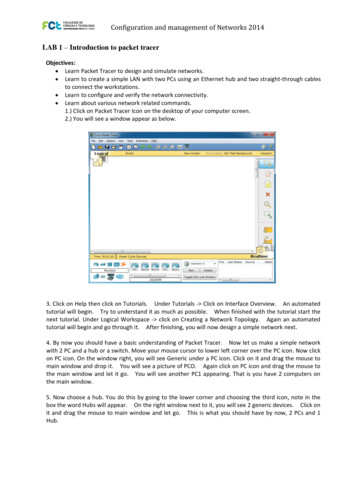
Transcription
Security TestingAbout the TutorialSecurity Testing is performed to reveal security flaws in the system in order to protect dataand maintain functionality.This tutorial explains the core concepts of Security Testing and related topics with simpleand useful examples.AudienceThis tutorial has been prepared for beginners to help them understand the basics of securitytesting.PrerequisitesBefore proceeding with this tutorial, you should have a basic understanding of softwaretesting and its related concepts.Copyright & Disclaimer Copyright 2018 by Tutorials Point (I) Pvt. Ltd.All the content and graphics published in this e-book are the property of Tutorials Point (I)Pvt. Ltd. The user of this e-book is prohibited to reuse, retain, copy, distribute or republishany contents or a part of contents of this e-book in any manner without written consent ofthe publisher.We strive to update the contents of our website and tutorials as timely and as precisely aspossible, however, the contents may contain inaccuracies or errors. Tutorials Point (I) Pvt.Ltd. provides no guarantee regarding the accuracy, timeliness or completeness of ourwebsite or its contents including this tutorial. If you discover any errors on our website orin this tutorial, please notify us at contact@tutorialspoint.comi
Security TestingTable of ContentsAbout the Tutorial . iAudience . iPrerequisites . iCopyright & Disclaimer. iTable of Contents . ii1.SECURITY TESTING OVERVIEW.1What is Security Testing? . 1Example . 12.SECURITY TESTING PROCESS.2Penetration Test – Workflow . 2Footprinting . 3Footprinting – Steps . 3Scanning . 4Enumeration . 5Exploitation . 63.SECURITY TESTING MALICIOUS SOFTWARE .8Malwares . 8Preventive Measures. 8Anti-Malware Software . 94.SECURITY TESTING HTTP PROTOCOL BASICS.10HTTP Protocol . 10Basic Features . 10Architecture . 11HTTP Parameters. 11ii
Security TestingHTTP Messages . 14HTTP Requests . 16HTTP Responses . 20HTTP Methods. 23HTTP Status Codes. 30HTTP Header Fields . 33Client Request Headers . 37Server Response Headers . 44Entity Headers . 47HTTP Security . 505.SECURITY TESTING HTTPS PROTOCOL BASICS .53When is HTTPS Required? . 53Basic Working of HTTPS. 536.SECURITY TESTING ENCODING AND DECODING .55What is Encoding and Decoding? . 557.SECURITY TESTING CRYPTOGRAPHY .61What is Cryptography? . 61How Encryption Works? . 61Cryptography Techniques. 618.SECURITY TESTING SAME ORIGIN POLICY .63What is Same Origin Policy? . 63Example . 63Same Origin policy Exceptions for IE . 63iii
Security Testing9.SECURITY TESTING TESTING COOKIES.64What is a Cookie? . 64Properties of Cookies . 64Cookie Contents . 64Types of Cookies . 64Testing Cookies . 65Viewing and Editing Cookies . 6510. SECURITY TESTING HACKING WEB APPLICATIONS .67Web Application - PenTesting Methodologies . 67OWASP Top 10 . 67Application - Hands On. 68Web Proxy. 69Configuring Burp Suite . 7011. SECURITY TESTING TESTING INJECTION .73Web Application - Injection . 73Examples . 74Preventing SQL Injection . 7612. SECURITY TESTING TESTING BROKEN AUTHENTICATION .77Preventing Mechanisms . 8013. SECURITY TESTING TESING CROSS-SITE SCRIPTING .81Types of XSS . 81Example . 82Preventive Mechanisms . 85iv
Security Testing14. SECURITY TESTING INSECURE DIRECT OBJECT REFERENCES .86Example . 86Preventive Mechanisms . 8915. SECURITY TESTING SECURITY MISCONFIGURATION .90Example . 90Preventive Mechanisms . 9216. SECURITY TESTING TESTING SENSITIVE DATA EXPOSURE .93Example . 93Preventive Mechanisms . 9417. SECURITY TESTING MISSING FUNCTION LEVEL ACCESS CONTROL .95Example . 95Preventive Mechanisms . 9718. SECURITY TESTING CROSS-SITE REQUEST FORGERY (CSRF).98Example . 98Preventive Mechanisms . 10019. SECURITY TESTING COMPONENTS WITH VULNERABILITIES .101Example . 101Preventive Mechanisms . 10220. SECURITY TESTING UNVALIDATED REDIRECTS AND FORWARDS .103Example . 103Preventive Mechanisms . 10421. SECURITY TESTING AJAX SECURITY .105Example . 105Preventive Mechanisms . 109v
Security Testing22. SECURITY TESTING WEB SERVICE SECURITY.110Preventive Mechanisms . 11223. SECURITY TESTING TESTING BUFFER OVERFLOWS .113Example . 113Preventive Mechanisms . 11724. SECURITY TESTING TESTING DENIAL OF SERVICE .118Symptoms of DoS . 118Preventive Mechanisms . 11925. SECURITY TESTING MALICIOUS FILE EXECUTION .120Example . 120Preventive Mechanisms . 12226. SECURITY TESTING – AUTOMATION TOOLS .123Open Source Tools . 123Specific Tool Sets . 124Commercial Black Box Testing tools . 125Free Source Code Analyzers . 125Commercial Source Code Analyzers . 127vi
1. Security Testing OverviewSecurity TestingSecurity testing is very important to keep the system protected from malicious activitieson the web.What is Security Testing?Security testing is a testing technique to determine if an information system protects dataand maintains functionality as intended. Security testing does not guarantee completesecurity of the system, but it is important to include security testing as a part of the testingprocess.Security testing takes the following six measures to provide a secured environment: Confidentiality - It protects against disclosure of information to unintendedrecipients. Integrity - It allows transferring accurate and correct desired information fromsenders to intended receivers. Authentication - It verifies and confirms the identity of the user. Authorization - It specifies access rights to the users and resources. Availability - It ensures readiness of the information on requirement. Non-repudiation - It ensures there is no denial from the sender or the receiverfor having sent or received the message.ExampleSpotting a security flaw in a web-based application involves complex steps and creativethinking. At times, a simple test can expose the most severe security risk. You can try thisvery basic test on any web application:1. Log into the web application using valid credentials.2.3. Log out of the web application.4.5. Click the BACK button of the browser.6.7. Verify if you are asked to log in again or if you are able go back to the logged inpage again.1
2. Security Testing ProcessSecurity TestingSecurity testing can be seen as a controlled attack on the system, which uncovers securityflaws in a realistic way. Its goal is to evaluate the current status of an IT system. It is alsoknown as penetration test or more popularly as ethical hacking.Penetration test is done in phases and here in this chapter, we will discuss the completeprocess. Proper documentation should be done in each phase so that all the stepsnecessary to reproduce the attack are available readily. The documentation also serves asthe basis for the detailed report customers receive at the end of a penetration test.Penetration Test – WorkflowPenetration test includes four major phases: Foot Printing Scanning Enumeration ExploitationThese four steps are re-iterated multiple times which goes hand in hand with the normalSDLC.2
Security TestingFootprintingFootprinting is the process of gathering the blueprint of a particular system or a networkand the devices that are attached to the network under consideration. It is the first stepthat a penetration tester uses to evaluate the security of a web application.After footprinting, a penetration tester can understand the pulse of a hacker. It is good tounderstand the complete system before testing its modules.Footprinting – Steps Information gathering Determining the range of the network Identifying active machines Identifying open ports and access points OS fingerprinting Fingerprinting services Mapping the networkTools Used in FootprintingFollowing are the common set of tools used in footprinting: Whois SmartWhois NsLookup Sam SpadeOther Techniques Used in FootprintingFootprinting may also involve collecting information such as: Company contact names, email addresses, and phone numbers Company deals and other parties involved News on mergers and acquisitions Links to other company-related sites Company's privacy policies3
Security TestingFlow DiagramScanningScanning is the second step that is performed after footprinting. It involves scanning openports, fingerprinting the operating system, and uncovering services on ports. The ultimategoal of scanning is to find open ports through external or internal network scanning,pinging machines, determining network ranges, and port scanning individual systems.Tools Used in ScanningFollowing are the common set of tools/resources used in Scanning: NMap Ping Traceroute Superscan Netcat NeoTrace4
Security TestingFlow DiagramEnumerationEnumeration is the next step after scanning. The goal of enumeration is to get a completepicture of the target. In this phase, a penetration tester tries to identify valid user accountsor poorly-protected shared resources using active connections to systems.Techniques Used in EnumerationFollowing are the common set of procedures used in Enumeration: Identifying vulnerable user accounts Obtaining Active Directory information Using snmputil for Simple Network Management Protocol enumeration Employing Windows DNS queries Establishing null sessions and connections5
Security TestingFlow DiagramExploitationExploitation is the last phase where a security tester actively exploits the securityweaknesses present in the system under consideration. Once the attack is successful, it ispossible to penetrate more systems in the domain, because the penetration testers thenhave the access to more potential targets that were not available before.Techniques Used in ExploitationThe types of exploitation are segregated into three different categories:1. Attack against WEB-SERVERSoSQL InjectionoCross-site ScriptingoCode InjectionoSession HijackingoDirectory Traversal2. Attack against NETWORKSoMan in the Middle AttackoSpoofingoFirewall TraversaloWLAN6
Security TestingoARP Poisoning3. Attack against SERVICESoBuffer OverflowsoFormat StringsoDosoAuthentication flawsFlow Diagram7
Security Testing3. Security Testing Malicious SoftwareMalicious software (malware) is any software that gives partial to full control of the systemto the attacker/malware creator.MalwaresVarious forms of malware are listed below: Virus – A virus is a program that creates copies of itself and inserts these copiesinto other computer programs, data files, or into the boot sector of the hard-disk.Upon successful replication, viruses cause harmful activity on infected hosts suchas stealing hard-disk space or CPU time. Worm - A worm is a type of malware which leaves a copy of itself in the memoryof each computer in its path. Trojan - Trojan is a non-self-replicating type of malware that contains maliciouscode, which upon execution results in loss or theft of data or possible system harm. Adware – Adware, also known as freeware or pitchware, is a free computersoftware that contains commercial advertisements of games, desktop toolbars, andutilities. It is a web-based application and it collects web browser data to targetadvertisements, especially pop-ups. Spyware - Spyware is infiltration software that anonymously monitors users whichenables a hacker to obtain sensitive information from the user's computer. Spywareexploits users and application vulnerabilities that is quite often attached to freeonline software downloads or to links that are clicked by users. Rootkit - A rootkit is a software used by a hacker to gain admin level access to acomputer/network which is installed through a stolen password or by exploiting asystem vulnerability without the victim's knowledge.Preventive MeasuresThe following measures can be taken to avoid presence of malware in a system: Ensure the operating system and applications are up to date with patches/updates. Never open strange e-mails, especially ones with attachments. When you download from the internet, always check what you install. Do not simplyclick OK to dismiss pop-up windows. Verify the publisher before you installapplication. Install anti-virus software.8
Security Testing Ensure you scan and update the antivirus programs regularly. Install firewall. Always enable and use security features provided by browsers and applications.Anti-Malware SoftwareThe following software help remove the malwares from a system: Microsoft Security Essentials Microsoft Windows Defender AVG Internet Security Spybot - Search & Destroy Avast! Home Edition for personal use Panda Internet Security MacScan for Mac OS and Mac OS X9
Security Testing4. Security Testing HTTP Protocol BasicsUnderstanding the protocol is very important to get a good grasp on security testing. Youwill be able to appreciate the importance of the protocol when we intercept the packetdata between the webserver and the client.HTTP ProtocolThe Hypertext Transfer Protocol (HTTP) is an application-level protocol for distributed,collaborative, hypermedia information systems. This is the foundation for datacommunication for the World Wide Web since 1990. HTTP is a generic and statelessprotocol which can be used for other purposes as well using extension of its requestmethods, error codes, and headers.Basically, HTTP is a TCP/IP based communication protocol, which is used to deliver datasuch as HTML files, image files, query results etc. over the web. It provides a standardizedway for computers to communicate with each other. HTTP specification specifies howclients’ requested data are sent to the server, and how servers respond to these requests.Basic FeaturesThere are following three basic features which make HTTP a simple yet powerful protocol: HTTP is connectionless: The HTTP client, i.e., the browser initiates an HTTPrequest. After making a request, the client disconnects from the server and waitsfor a response. The server processes the request and re-establishes the connectionwith the client to send the response back. HTTP is media independent: Any type of data can be sent by HTTP as long asboth the client and server know how to handle the data content. This is requiredfor client as well as server to specify the content type using appropriate MIME-type. HTTP is stateless: HTTP is a connectionless and this is a direct result that HTTPis a stateless protocol. The server and client are aware of each other only during acurrent request. Afterwards, both of them forget about each other. Due to thisnature of the protocol, neither the client nor the browser can retain informationbetween different requests across the web pages.HTTP/1.0 uses a new connection for each request/response exchange whereas HTTP/1.1connection may be used for one or more request/response exchanges.10
Security TestingArchitectureThe following diagram shows a very basic architecture of a web application and depictswhere HTTP resides:The HTTP protocol is a request/response protocol based on the client/server architecturewhere web browser, robots, and search engines etc. act as HTTP clients and the web serveracts as a server. Client - The HTTP client sends a request to the server in the form of a requestmethod, URI, and protocol version, followed by a MIME-like message containingrequest modifiers, client information, and possible body content over a TCP/IPconnection. Server - The HTTP server responds with a status line, including the protocolversion of the message and a success or error code, followed by a MIME-likemessage containing server information, entity meta information, and possibleentity-body content.HTTP – Disadvantages HTTP is not a completely secured protocol. HTTP uses port 80 as default port for communication. HTTP operates at the application Layer. It needs to create multiple connections fordata transfer, which increases administration overheads. No encryption/digital certificates are required for using HTTP.HTTP ParametersWe will discuss here a few important HTTP Protocol Parameters and their syntax that arerequired in constructing the request and response messages while writing HTTP client orserver programs. We will cover the complete usage of these parameters in subsequentchapters while explaining the message structure for HTTP requests and responses.HTTP Version11
Security TestingHTTP uses a major . minor numbering scheme to indicate versions of the protocol.The version of an HTTP message is indicated by an HTTP-Version field in the first line. Hereis the general syntax of specifying HTTP version number:HTTP-Version "HTTP" "/" 1*DIGIT "." 1*DIGITExampleHTTP/1.0orHTTP/1.1Uniform Resource Identifiers (URI)URI is simply formatted, case-insensitive string containing name, location etc. to identifya resource. For example, a website name, a web service etc. A general syntax of URI usedfor HTTP is as follows:URI "http:" "//" host [ ":" port ] [ abs path [ "?" query ]]Here, if the port is empty or not given, port 80 is assumed for HTTP and anempty abs path is equivalent to an abs path of "/". The characters other than those inthe reserved and unsafe sets are equivalent to their ""%" HEX HEX" encoding.ExampleFollowing two URIs are equivalent:http://abc.com:80/ tp://ABC.com:/%7esmith/home.htmlDate/Time FormatsAll HTTP date/time stamps must be represented in Greenwich Mean Time (GMT), withoutexception. HTTP applications are allowed to use any
What is Security Testing? Security testing is a testing technique to determine if an information system protects data and maintains functionality as intended. Security testing does not guarantee complete security of the system, but it is important to include security testing as a part of the testing process. Security testing takes the following .










